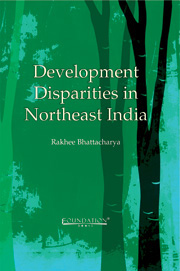Book contents
- Frontmatter
- Contents
- Preface
- List of Figures
- List of Tables
- 1 Challenges of Disparity in the Northeast
- 2 Dimensions of Disparity in the Northeast
- 3 Facets of Government Finance in the Northeast
- 4 Economy of Insurgency in the Northeast
- 5 Energy Interplay in the Northeast
- 6 Development Initiatives in the Northeast
- Index
5 - Energy Interplay in the Northeast
Published online by Cambridge University Press: 05 June 2012
- Frontmatter
- Contents
- Preface
- List of Figures
- List of Tables
- 1 Challenges of Disparity in the Northeast
- 2 Dimensions of Disparity in the Northeast
- 3 Facets of Government Finance in the Northeast
- 4 Economy of Insurgency in the Northeast
- 5 Energy Interplay in the Northeast
- 6 Development Initiatives in the Northeast
- Index
Summary
Assam in India's Energy Sector
Despite huge reserves of natural resources, economic development in Northeast India has been arrested due to many complex issues including the illegal economy of insurgency, which has captured the region (Chapter 4). As argued by Bhaumik, resources by themselves have not resulted in a buoyant economy in the region. He shows that it has proven exploitable reserves of 846 million tons of coal, recoverable reserve of 421 million tons of hydrocarbons and a hydroelectric power potential of nearly 60,000 MW. Assam and Arunachal Pradesh are gifted with rich oil bearing shale formation that could yield 15 billion tons of oil. Despite being so rich in natural resources the region suffers from power shortage, water crises, and high gas and petroleum prices, which add misery to the lives of the Northeasterners. This chapter assesses another important dynamic of this region – its resources potential – which has remained underutilized for achieving development. The study takes up only the energy scenario and attempts to find reasons for why such huge reserves of energy could not bring economic prosperity in Northeast India. Energy has become the propelling factor in economic growth, more so since globalization. Globalization has reshaped energy markets along with an expansion of oil and natural gas markets. But this industry is actually facing an enormous growth challenge to keep ahead of the astounding demand. India's energy sector has made a long journey; its capacity has increased from a mere 0.25 million tons per annum from one field in Digboi in Assam in 1947, to 34 million tons of crude oil along with 32 billion cubic meters of natural gas per annum in 2005–06.
- Type
- Chapter
- Information
- Development Disparities in Northeast India , pp. 129 - 147Publisher: Foundation BooksPrint publication year: 2011



